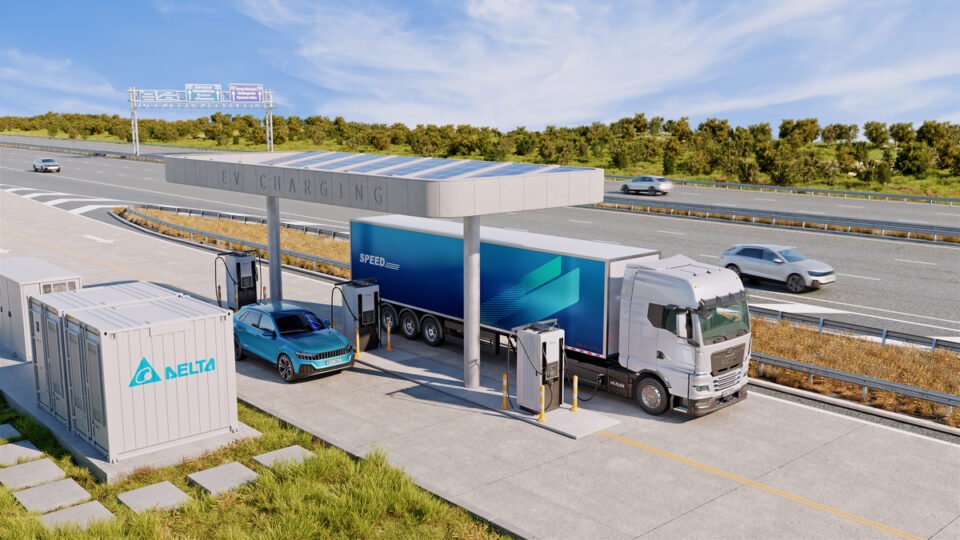After several bumper years for electric vehicle (EV) sales, the latest BNEF Electric Vehicle Outlook 2024reflects a marked slowdown in the passenger vehicle segment. In contrast, the commercial EV market – encompassing e-buses, electric delivery vans and long-haul trucks – continues to expand robustly, driven by distinct dynamics and supportive infrastructure developments.
In this article, Vincent Lin, Vice President of E-Mobility & Smart Energy Solutions Business Development at Delta Electronics EMEA region, explains what it will take to accelerate the adoption of commercial EVs and the infrastructure necessary to support the decarbonisation of transport.
What are the key trends in the commercial EV market right now?
The commercial EV market is at an inflection point, driven by different factors than those affecting the passenger vehicle segment. Growth has been fuelled by green transportation targets, government incentives and infrastructure improvements. Municipal buses and electric delivery vans are benefiting from increased range, more robust charging systems and significant policy support in regions such as Europe.
In Europe, demand for commercial EVs continues to grow despite challenges such as high energy prices and lagging public infrastructure. Commercial vehicles, particularly in logistics, often circumvent these issues by relying on private, depot-based charging solutions rather than public charging networks. This dynamic sharply contrasts with the passenger EV market, where costs, infrastructure and incentives significantly impact sales.
In Asia, China and India are rapidly expanding their commercial EV fleets thanks to extensive government subsidies and aggressive policy targets. This growth is driving down costs and fostering innovation across the global market.
How is the commercial EV segment developing?
Decarbonising commercial transport is underway and set to accelerate. Light-duty delivery vans and electric trucks are on a rapid growth trajectory in parts of Europe. BNEF expects new greenhouse gas rules in Europe and the US to boost manufacturing and sales of electric and fuel-cell trucks.
A standout success story is the electrification of municipal buses. Sales are projected to exceed 60 per cent of global bus sales by 2030 and reach 83 per cent by 2040. This rapid adoption is driven by municipalities worldwide striving to combat climate change and improve air quality. Green transportation targets, low-emission zones, subsidies and other policy initiatives have increased the number of electric buses by more than half in 2023, boosting their global share to 42 per cent.
What contributes to commercial EVs’ success, and how will this segment evolve?
The economics of commercial vehicles, including financing and payback periods, differ significantly from those of passenger cars. Green transportation targets and subsidies have been essential in growing this sector. Additionally, commercial vehicles don’t rely as heavily on public charging infrastructure. Vehicles such as e-buses and electric vans for last-mile logistics typically have larger battery packs and greater range. They also return to depots during the day and overnight to recharge their batteries.
The availability of high-power chargers, such as Delta’s UFC 500, enables rapid recharging compared to typical public chargers. Moreover, commercial settings are increasingly installing renewable energy sources, such as solar PV, on their premises, reducing the cost of fleet recharging.
Long-distance haulage presents different challenges. Trucks covering vast distances operate on tight schedules, and charging times must fit within drivers’ legally mandated break periods to avoid delays in delivery schedules. Enter Megawatt Charging Solutions (MCS), which can deliver substantial power to e-trucks quickly – up to 3.75MW, enough to charge a heavy-duty truck in minutes, compared to hours with today’s standard chargers. While the first e-truck charging corridors have launched across Europe, MCS charging is expected to become available along motorways and other high-frequency routes by 2026. Many MCS installations will be in remote locations with limited grid capacity, making it vital to combine MCS units with energy storage and power stabilisation solutions.
What does the future hold for commercial EVs over the next decade?
Government incentives will remain essential for developing EV infrastructure. With economic pressures facing governments worldwide, striking a balance between supporting the energy transition and addressing other priorities will continue to pose challenges.
Despite these factors and the current lull in passenger EV sales, the long-term outlook for EVs remains positive. BNEF data suggests that by 2040, nearly three-quarters of global passenger vehicle sales will be electric.
However, at Delta, we expect a divergence within the commercial segment. Last-mile delivery vehicles are likely to advance further down the electrification path, supported by faster and higher-capacity charging that also benefits passenger EVs.
In heavy-duty haulage, we anticipate a mix of battery-electric and hydrogen-powered trucks, with an expanding MCS network supporting battery-powered vehicles. Hydrogen fuel cells, capable of covering greater distances, will become an important part of the decarbonisation solution for long-haul transport.
As we continue to improve the power efficiency, density and grid impact of charging systems, the commercial EV segment is poised to lead the decarbonisation of road transport. The combination of advancing technology, supportive policies and a growing economic case for electrification will cement commercial EVs as pivotal players in reducing global transportation emissions.
For more information, visit delta-emea.com/en-GB/solutions/EV-Charging-Solutions/ALL/

